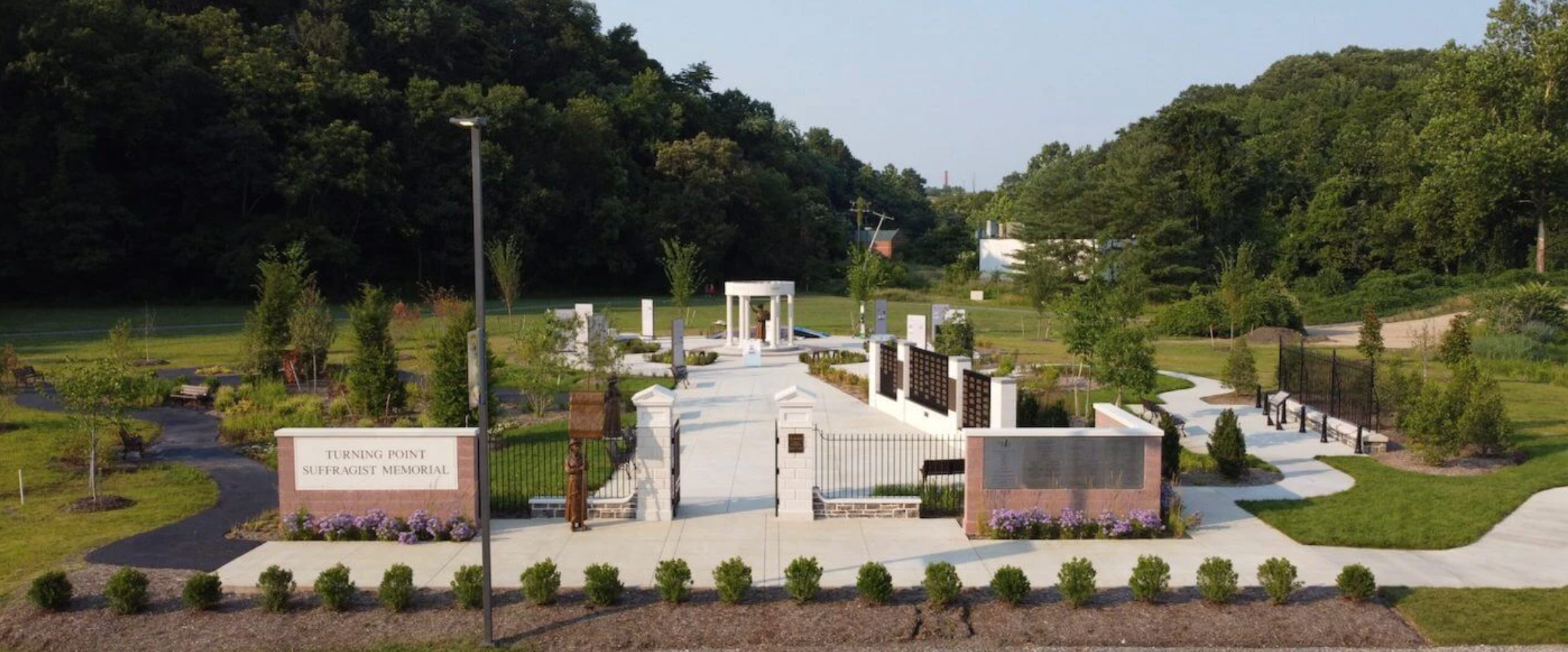
With contributions in music, medicine, and more, Virginia women have made their mark.
You don’t have to travel far to find a woman’s touch throughout the commonwealth.
Named after Queen Elizabeth I, also known as the Virgin Queen, the state was home to the first successful English colony in 1607. The Old Dominion also became the birthplace of country music in 1927. In 1951, the non-consensual harvesting of tissue samples from a tumor sparked a medical revolution.
Want to guess what those historical events had in common? There was a woman at the heart of each story.
We’ve put together a list of places across Virginia where you can learn more about these women-inspired events and others like them.
Turning Point Suffragist Memorial
Location: Occoquan Regional Park, 9751 Ox Road, Lorton, VA

The memorial located within Occoquan Regional Park, now operated by NOVA Parks, highlights the story of the suffragist movement and the women who made it happen.
The monument rests near the grounds of a former Virginia prison, The Occoquan Workhouse. In 1917, a “Night of Terror” occurred at the prison when suffragists were beaten, choked, stabbed, force-fed, and more for protesting then-President Woodrow Wilson. News spread of the treatment the women endured, catching the public’s attention. When they were released, the once-heckled group of women who became known as the Silent Sentinels gained a positive national following.
According to the Turning Point Suffragist Memorial’s website, the objective is to educate, inspire, and empower present and future generations to remain vigilant in the quest for liberty, freedom, and equal rights.
Pocahontas Statue
Location: 1368 Colonial Pkwy, Jamestown, VA

Do you paint with all the colors of the wind? A statue in Pocahontas’ honor on Jamestown Island pays tribute to the young peacekeeper, central to the first English settlement in Virginia.
Sadly, the real story of Pocahontas isn’t quite like the Disney fairytale. In reality, Chief Powhatan’s daughter was kidnapped as a teenager during the First Anglo-Powhatan War. During captivity, she met a settler and tobacco planter, John Rolfe, whom she later married. The couple moved to England, where she died from an illness at about age 21.
The statue at Jamestown took longer than originally projected to complete. Funding fell short for the 300th anniversary of the Jamestown Settlement in 1907, and the federal government stepped in with the money needed to complete the project six years later. Finally, a dedication ceremony took place in June 1922.
Fun fact: The statue’s hands are now a bright copper color because of people holding them for photo opportunities.
Mount Vernon
Location: 3200 Mount Vernon Memorial Highway, Mount Vernon, VA

The Virginia home of President George Washington could’ve been lost to time had it not been for a South Carolina woman by the name of Ann Pamela Cunningham.
In 1853, Cunningham received a letter from her mother who saw Mount Vernon during a homeward bound steamboat trip. The writer was “painfully distressed” at the “ruin and desolation” of the first president’s estate. According to the Advisory Council on Historic Preservation, the mother’s letter posed the question: “If the men of America have seen fit to allow the home of its most respected hero to go to ruin, why can’t the women of America band together to save it?”
The letter inspired Cunningham, who founded the Mount Vernon Ladies’ Association. After fundraising to purchase the estate, the organization did just that in 1859 for $200,000. A restoration effort began shortly thereafter—and more than 160 years later, the Mount Vernon Ladies’ Association still owns the property.
Birthplace of Country Music Museum
Location: 101 Country Music Way, Bristol, VA

From July 25 through August 5, 1927, the top two floors of the Taylor-Christian Hat Company served as a makeshift recording studio. Known and undiscovered musical artists alike descended on Bristol, recording songs in the style of the Blue Ridge region. Among those performers was the Virginia-based Carter Family.
Previously unknown to the mainstream, A.P., his wife Sara, and his sister-in-law Maybelle Carter from Maces Springs went to the city nestled in the Appalachian mountains after seeing a newspaper ad looking for “hillbilly music” singers. The family recorded multiple songs on the last day of July for $50 a pop, broadcasting their unique style to the masses.
By 1930, the Carters had more than 300,000 record sales under their belt—and a young daughter, too. Her name was June Carter, and she’d go on to not only make a name for herself in the music industry, but also marry one of the premiere rock and rollers, Johnny Cash. Though born four and a half years after those initial recordings in 1927, Cash called the Bristol Sessions “the single most important event in the history of country music.”
Nowadays, the Birthplace of Country Music Museum, a Smithsonian affiliate, tells the story of not only the artists, but also of Ralph Peer, a Victor Talking Machine Company producer, and the musical magic he made in the mountains. The museum recently unveiled a new exhibit, “I’ve Endured: Women In Old-Time Music.”
Grandmother Moses House
Location: Mill Place Parkway, south of Laurel Hill Road, Verona, VA

In 2006, “Sugaring Off” sold for $1.2 million and became Grandma Moses’ highest-selling painting. It was an incredible feat, considering the artist—whose legal name was Anna Mary Robertson Moses—didn’t start painting until she was in her late 70s.
In 1887, newlyweds Anna and Thomas Moses accidentally moved to the Staunton area after boarding the wrong train out of Washington, DC. Rather than continue south to North Carolina, the couple, who were both in their 20s at the time, settled in the Shenandoah Valley region. They purchased their first home in 1901 known as “Mount Airy,” where they lived for two years.
The Verona property inspired at least three pieces of artwork prior to Anna’s death in 1961 at age 101. A historical marker now displays the nearly 200-year-old home’s relation to the famous artist.
Location: 410 3rd St. Southwest, Roanoke, VA
The statue of a Roanoke woman isn’t up yet, but the bronze likeness of Henrietta Lacks will greet visitors in the Star City this coming fall. Lacks died from cancer at age 31, but due to an unethical (yet legal at the time) practice by her doctor, saved countless lives.
As a Black woman with limited medical options in the 1950s, Lacks sought treatment at Johns Hopkins Hospital in Maryland. Without her consent, Lacks’ doctor collected tissue samples from a tumor and sent them off for testing. Unlike most cells, the “HeLa cells” doubled daily, leading to decades of clinical research, medical breakthroughs, and effective vaccines.
Lacks’ statue will stand in place of a former monument to Confederate Gen. Robert E. Lee, which Roanoke resident William Foreman tore down in 2020.
Politics

VIDEO: Youngkin won’t add legal protection for birth control access
Access to birth control remains vulnerable to potential future attacks after Republican Gov. Glenn Youngkin effectively blocked a bill that would...

Trump says he would allow red states to track pregnancies, prosecute abortion ban violators
In an interview published by Time magazine this week, former president Donald Trump detailed his plans for a potential second term and said he would...
Local News

The zodiac signs of 12 iconic women offer insight into their historic accomplishments
Zodiac signs can tell you a lot about someone’s personality. Whether they’re an earth, water, air, or fire sign, these 12 categories (which are...

Virginia verses: Celebrating 5 poetic icons for National Poetry Month
There’s no shortage of great writers when it comes to our commonwealth. From the haunting verses of Edgar Allan Poe, who found solace in Richmond's...





